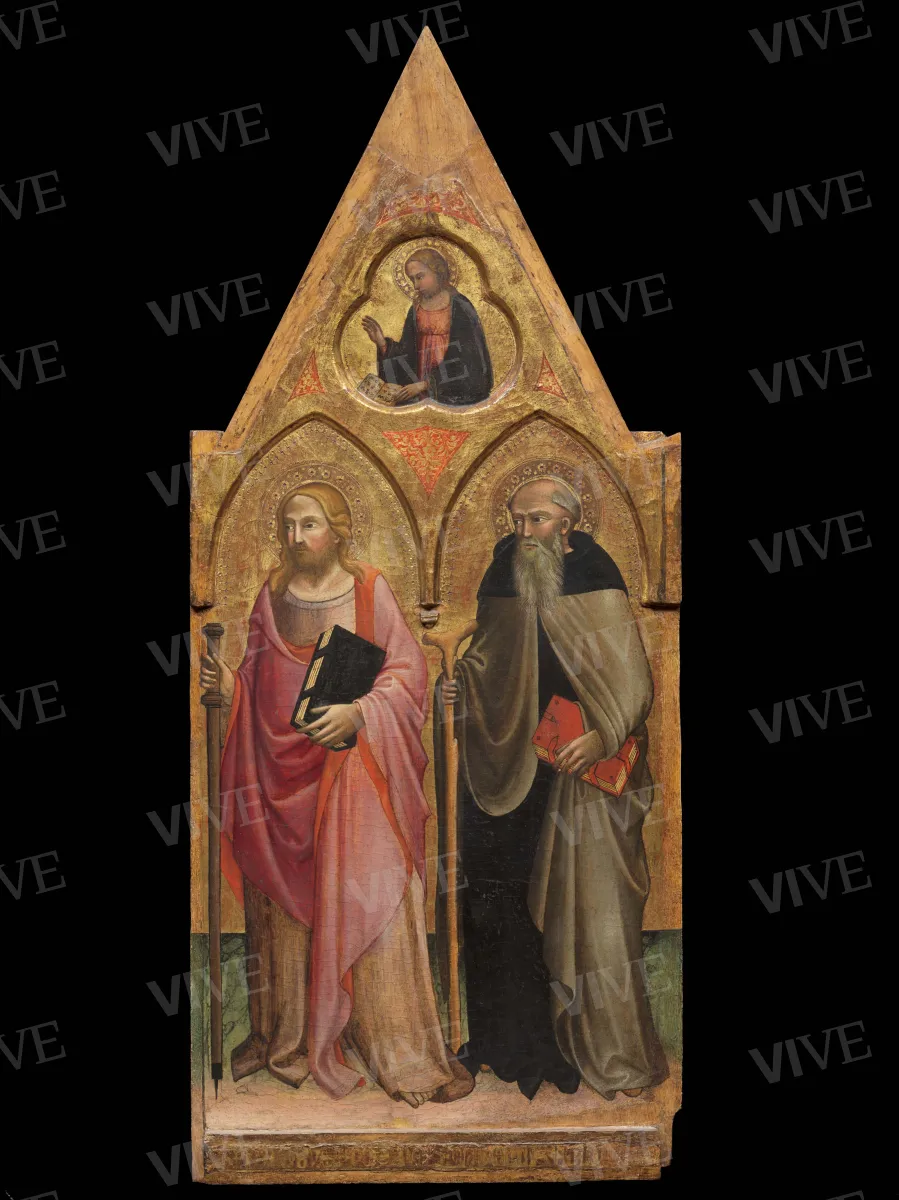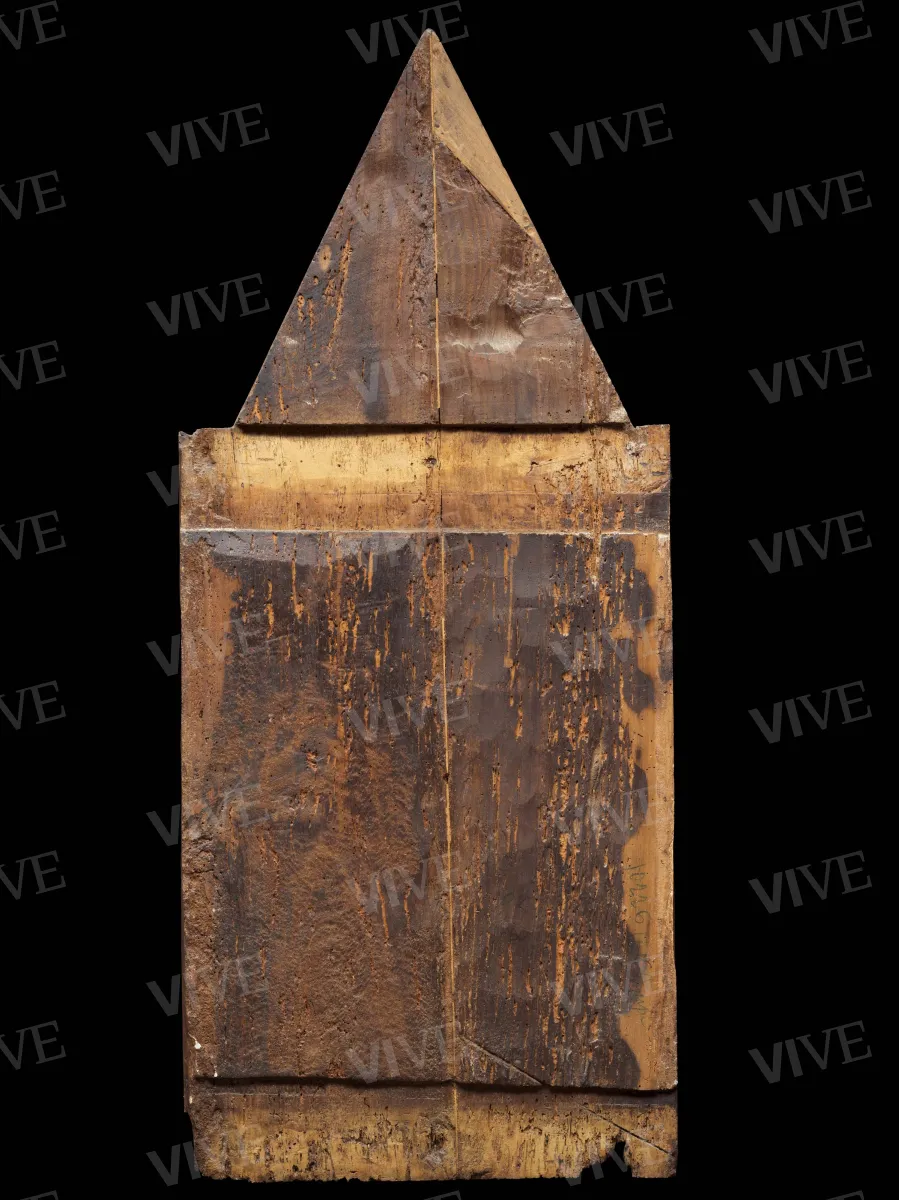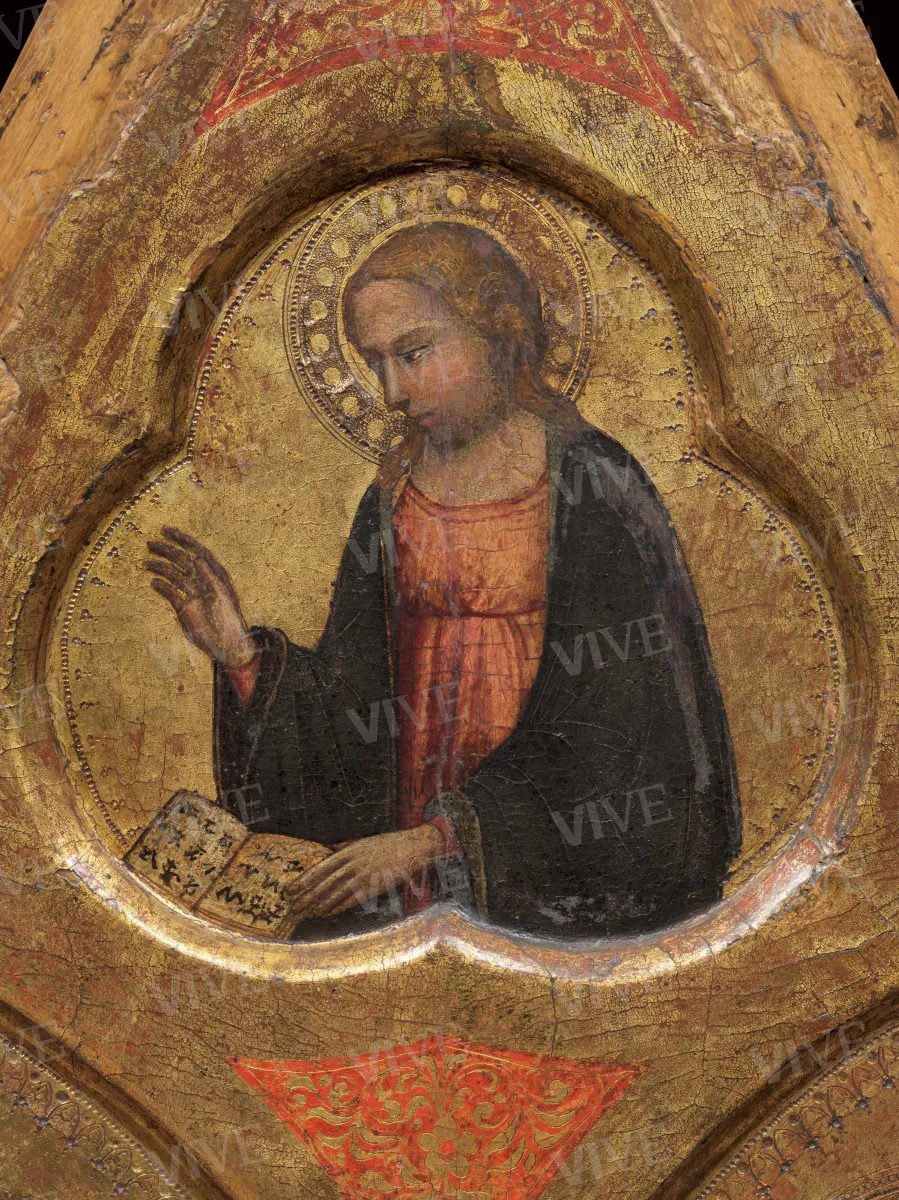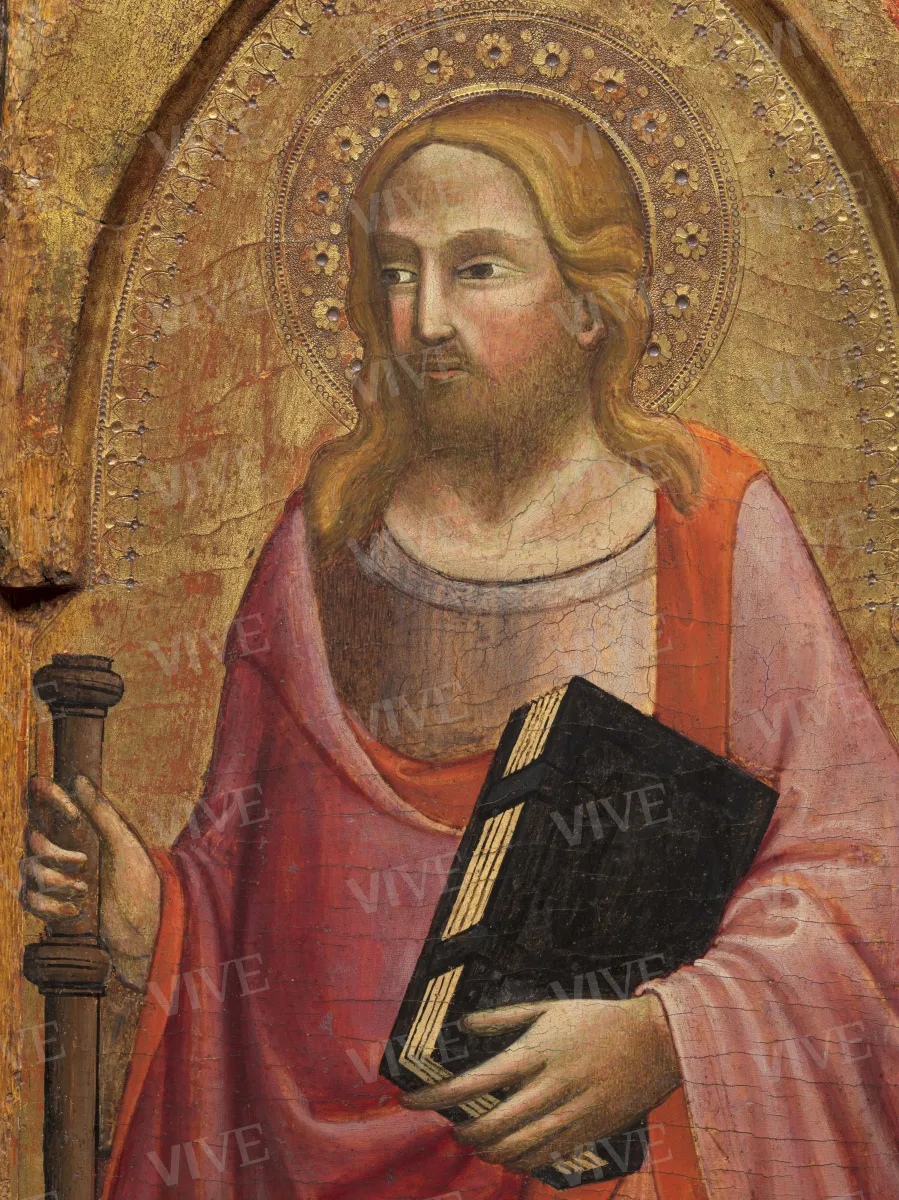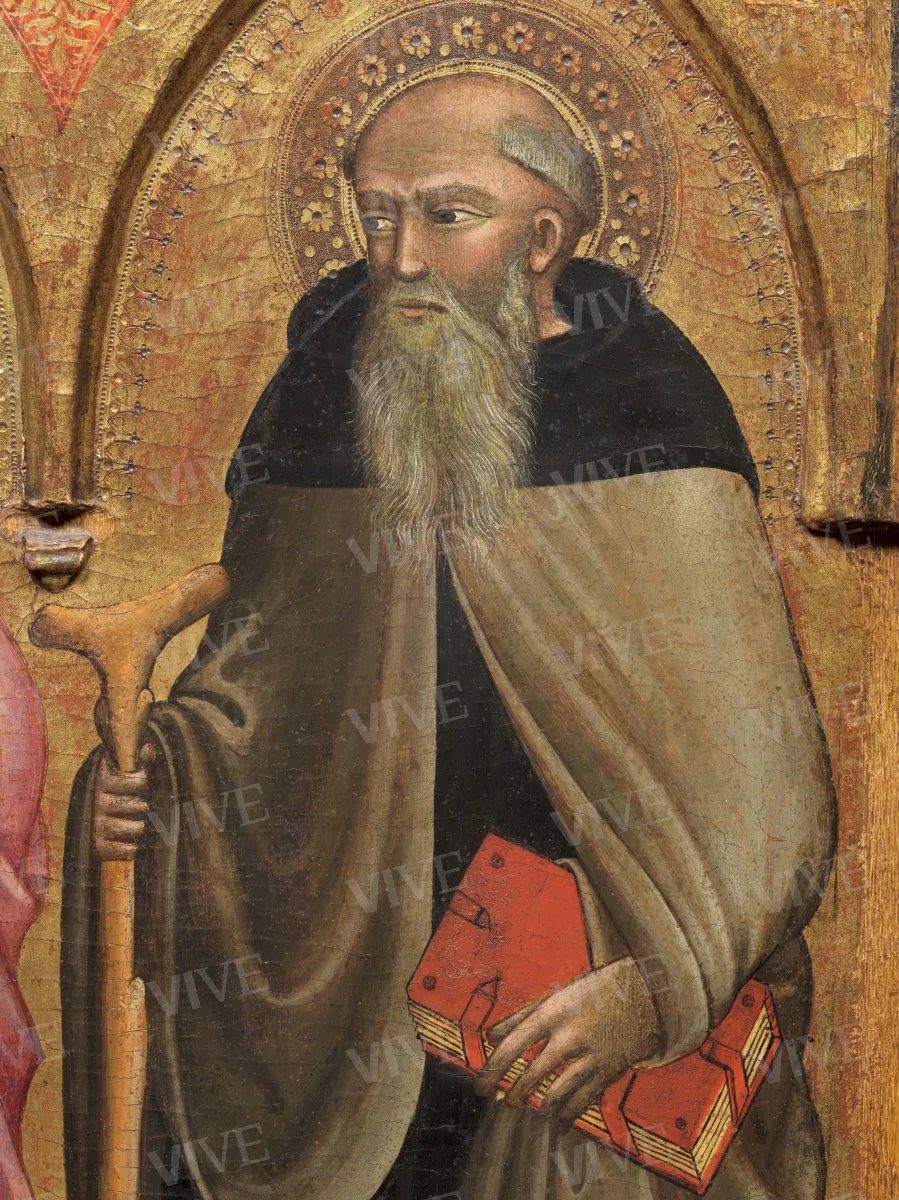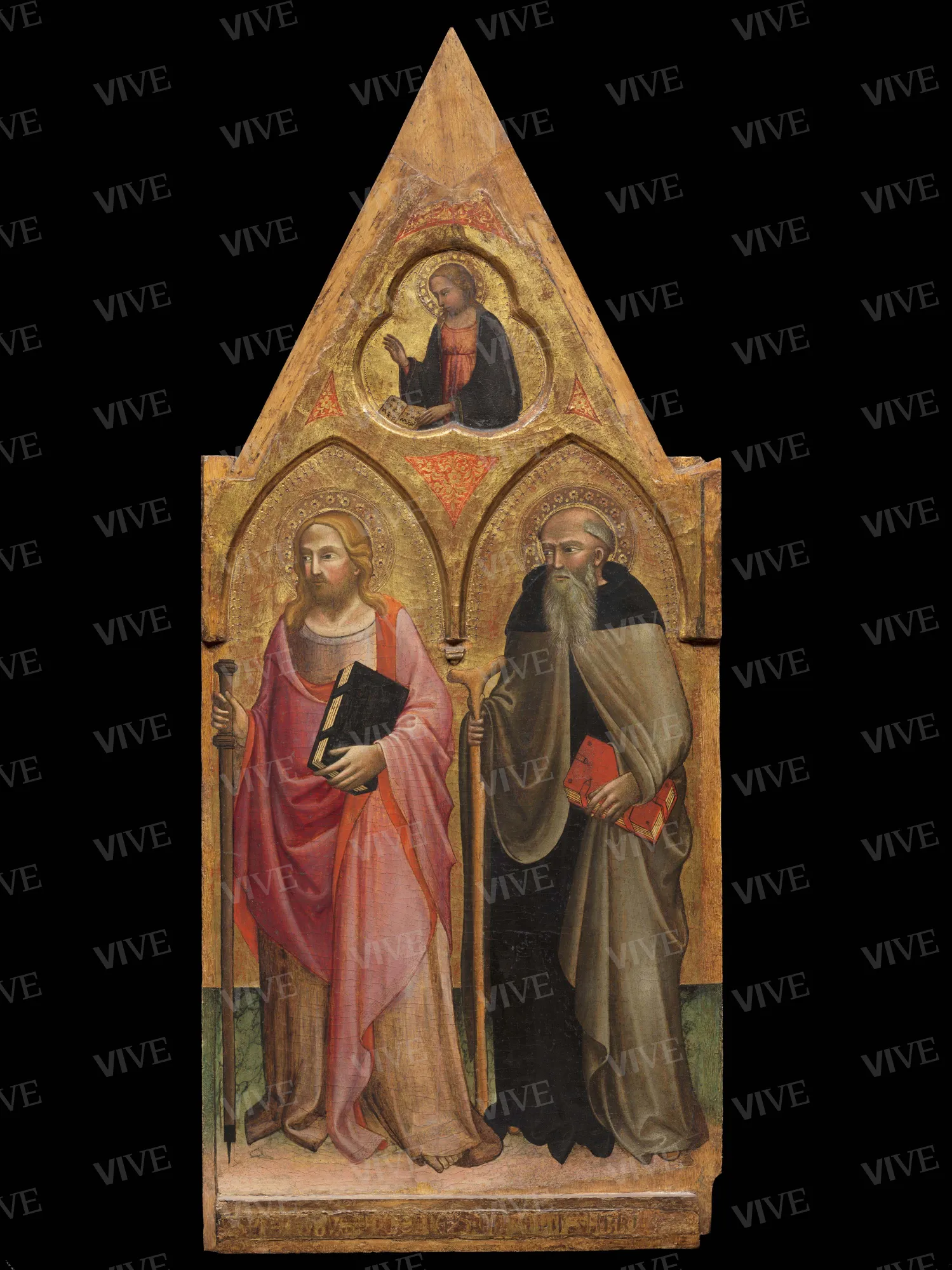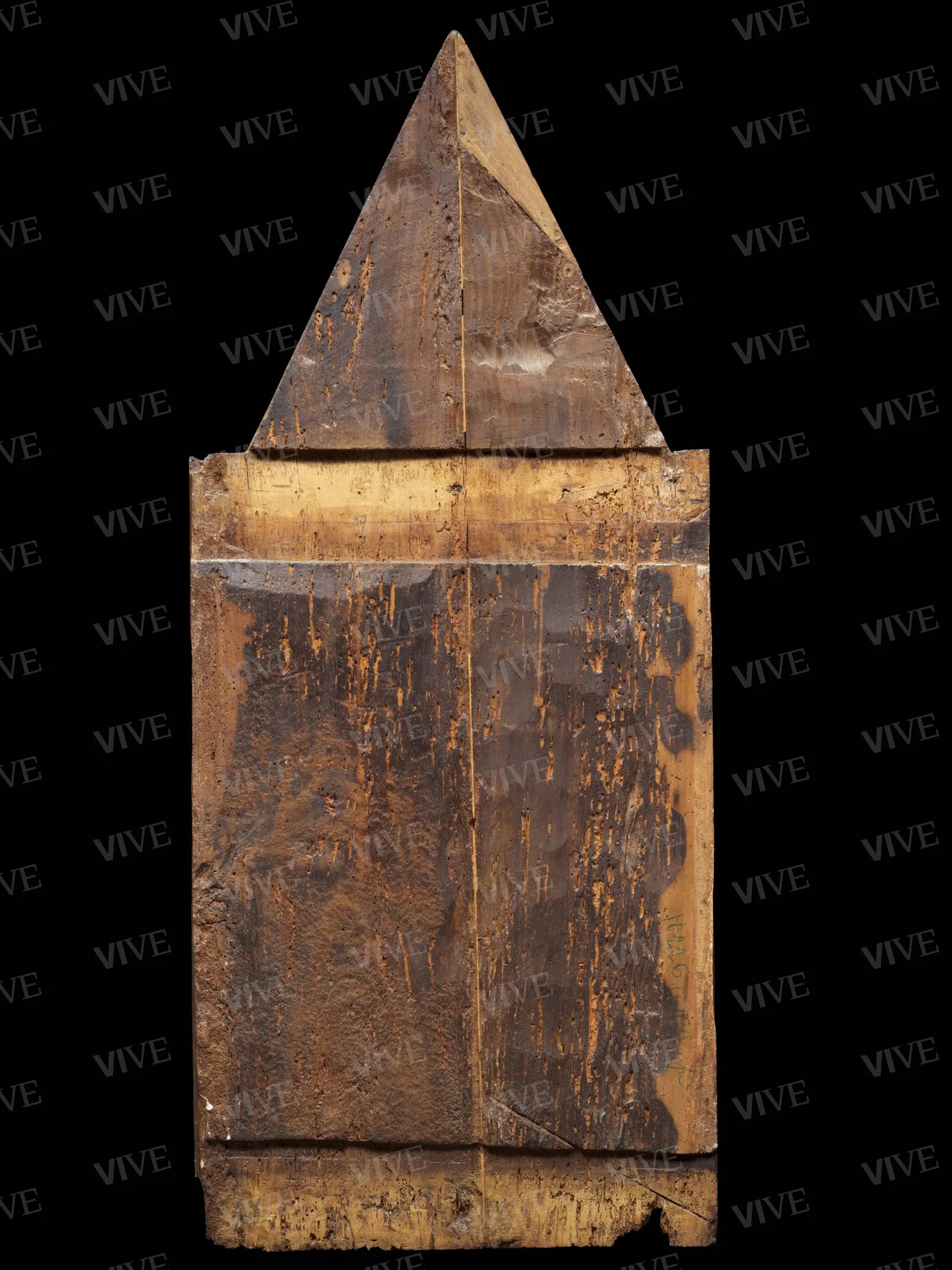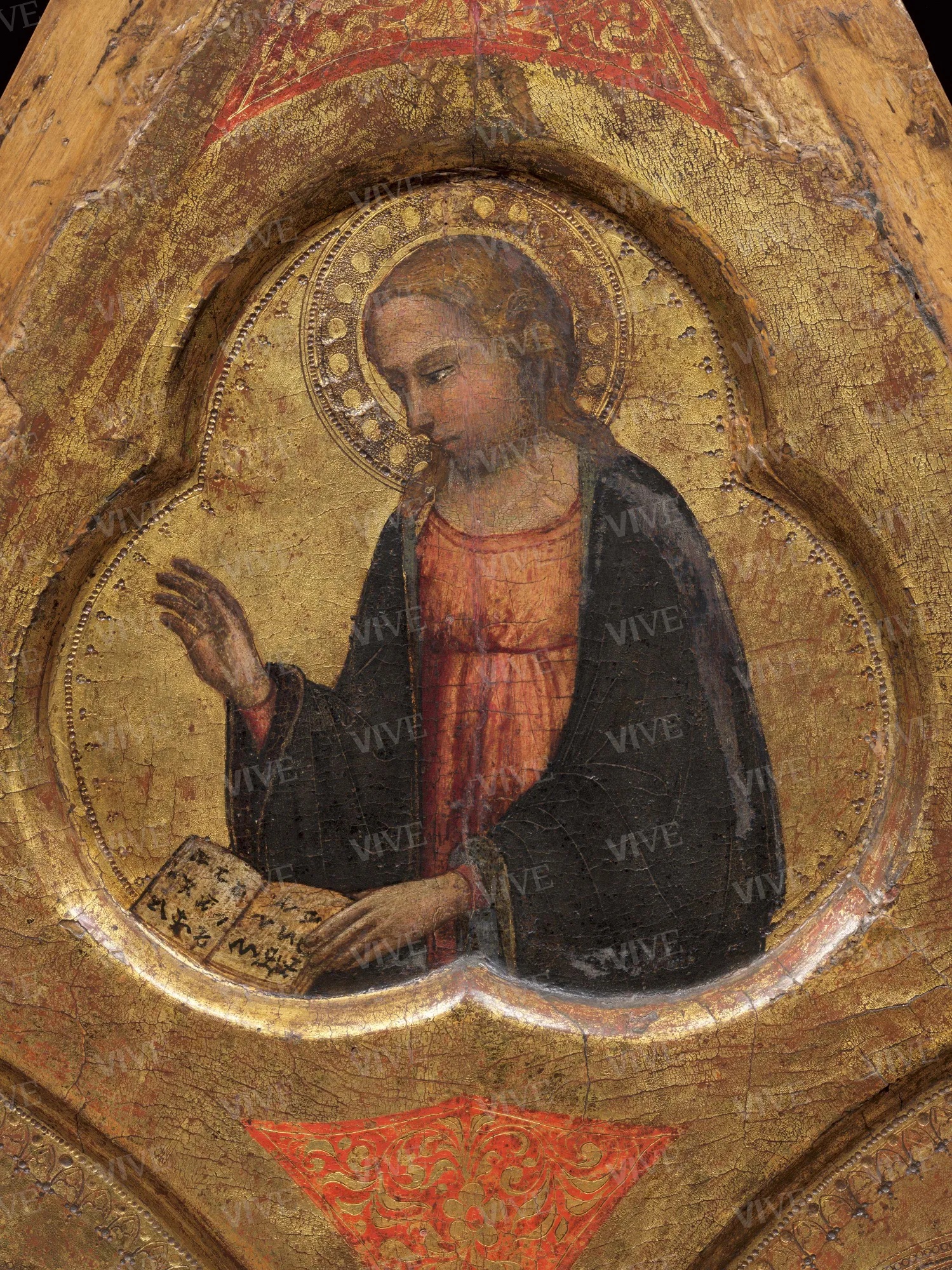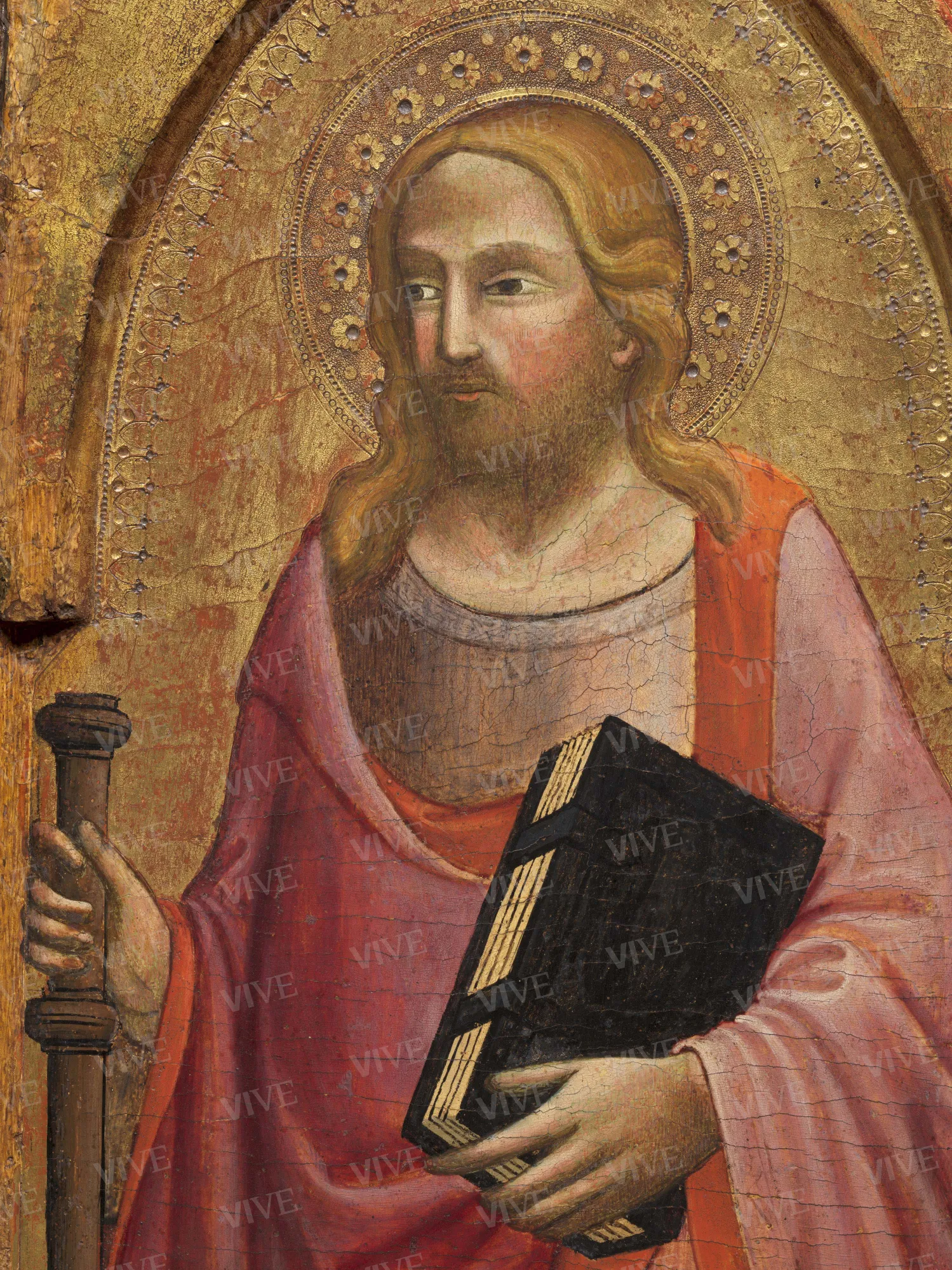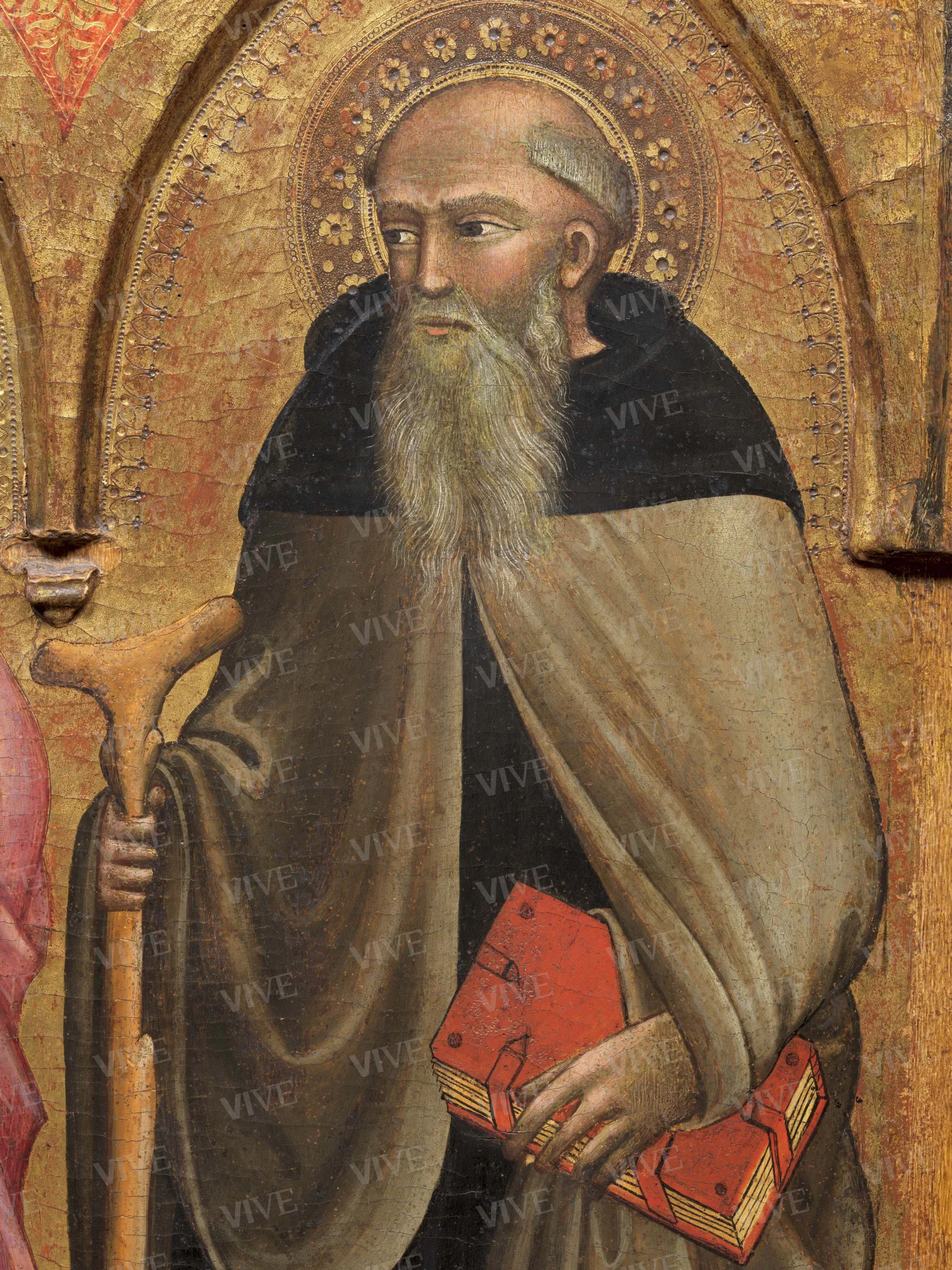Saint James the Apostle, Saint Anthony the Abbot, Our Lady of the Annunciation
Circle of Niccolò di Pietro Gerini Last decade of 14th century
Cuspidate compartment of polyptych depicting Saints James the Apostle and Anthony Abbot and, in the trefoil oculus at the top, the Annunciation. The state of preservation is fair, although there are several clefts and breaks in the painted surface. It is likely that the surviving compartment was part of a triptych and was likely placed to the right of the central panel. The painting seems datable to the end of the fourteenth century and attributable to the circle of Niccolò di Pietro Gerini.
Cuspidate compartment of polyptych depicting Saints James the Apostle and Anthony Abbot and, in the trefoil oculus at the top, the Annunciation. The state of preservation is fair, although there are several clefts and breaks in the painted surface. It is likely that the surviving compartment was part of a triptych and was likely placed to the right of the central panel. The painting seems datable to the end of the fourteenth century and attributable to the circle of Niccolò di Pietro Gerini.
Details of work
Catalog entry
The cuspidate panel depicts Saints James the Apostle and Anthony Abbot framed within pointed arches. Above the two figures, in the triangular portion of the upper portion and within a trefoil oculus, is the scene of the Annunciation. Saint James is wearing a purplish tunic with a pink cloak, holding a pilgrim’s staff with his right hand and a book with the other, in honor of his epistolary activity. His face is framed by long blond hair down to his shoulders and a full, medium-length beard. His halo is finely decorated with a punched flower motif framed by four small circles. The same decoration is present in the halo of Saint Anthony Abbot, who is bald with a long white beard. He is clad in a black cowled tunic and a gray cloak and is holding a large volume with red cover in his left hand and his iconographic Tau-tipped staff in his right hand.
Both saints are depicted on a gold background with barren ground in front of them and luxuriant grass behind.
The Virgin Mary is wearing a red tunic with a blue cloak and is depicted as she is intent on reading. This detail makes it all the easier to identify the scene as the Annunciation, so it is plausible to assume that there was another compartment with an oculus containing the announcing angel, and that this should be on the left, as suggested by the direction of Mary’s gaze.
That the panel is part of a polyptych is also evident from the direction of the gaze of the two saints, who are both facing left. The presence of the Annunciation in the Palazzo Venezia panel allows us to infer that this was the compartment immediately to the right of the central panel, and that the panel with the Archangel Gabriel was, therefore, even further to the left.
Both edges of the panel have been tampered with. The thickness on the left edge, however, makes it easier to assume the presence of some sort of system designed to anchor this to another panel. The right edge, on the other hand, seems to determine the end of the entire polyptych, as can also be deduced from the decoration with vertical strokes present in the portion of the frame that has been preserved. The panel must therefore have been part of a triptych.
The painting has only rarely been dealt with by art historians. In Santangelo’s catalog, Saint James is mistakenly identified as Saint John the Evangelist (Santangelo 1947, p. 35). Santangelo states that in the Collezione Sterbini the painting was attributed to Lorenzo di Niccolò, because of similarities with the panel depicting Saints John the Baptist, James the Greater, and Anthony the Abbot in the Museo Nazionale di San Matteo in Pisa. This latter painting, however, more correctly traced by the scholar to Spinello Aretino, also allows us to attribute the panel in Palazzo Venezia to the latter’s circle (Santangelo 1947, p. 35). Federico Zeri (1955, p. 9), on the other hand, does not attribute the work to a specific artist, but more generically attribute it to the early fifteenth-century Tuscan school.
Comparisons with the Pisan panel by Spinello Aretino seem to be due more to iconographic issues than to authentically stylistic issues. The painting constitutes the right side of a polyptych that can be dated to the middle of the last decade of the fourteenth century and was formerly in the cathedral of Pisa, which also includes the panel with Saints Ranieri, Sixtus II, and Michael the Archangel in the Sala del Capitolo in Palazzo Arcivescovile in Pisa, the central compartment with the Madonna and Child and eight angels in the Harvard Museum in Cambridge, and two panels with the Archangel Gabriel and the Virgin Annunciate in the Fitzwilliam Museum (Weppelmann 2011, pp. 241–247). The face of the Virgin Annunciate in Cambridge, even taking into consideration the obvious difference in quality, is, I think, more closely related to the same subject in the Palazzo Venezia painting. The two US panels, on the other hand, have raised more doubts in art history scholars regarding a summary attribution to Spinello, and the name of Niccolò di Pietro Gerini has repeatedly been mentioned (Bresciani 2021, p. 175). Gerini's sketchier style, clearly evident in the peculiarly deep contour lines, is similar to the style deployed in the Palazzo Venezia panel. Other details also seem to recall works by Niccolò Gerini—the punched elements in the haloes of the Roman saints and the four-petaled flower between four small spheres are almost identical to elements used by the painter for the haloes of the saints of the side panels of the Collegonzi triptych in Vinci, dated to the middle of the ninth decade of the fourteenth century (Chiodo 2005, pp. 50–51). It therefore also seems possible to backdate the two Roman saints to the last decade of the fourteenth century, with clear reference to the circle of Niccolò di Pietro Gerini rather than Spinello Aretino.
Valentina Fraticelli
Entry published on 12 February 2025
State of conservation
Fair. Some sections of the frame are missing, particularly the edge of the right end and the molding that framed the cuspidate structure. The left margin has obviously been tampered with, suggesting that there was another compartment on that side. A large tear on the painted surface and preparatory layers is visible at the cusp. There are abrasions and gaps on the painted surface which have been reintegrated in an easily recognizable style.
Restorations and analyses
Noticeable repainting using a very specific technique (hatching), particularly evident along the margins, indicates that restoration took place in recent decades, even though it can not be more accurately determined when.
Inscriptions
Gothic capital letter inscription engraved on gold background placed in the lower frame: "S IACOBUS APOSTO[LU)S ANTONIUS ABB[AS]"
Provenance
Rome, Palazzo Sterbini, Collezione Giulio Sterbini;
Rome, Collezione Lupi;
Rome, Collezione Giovanni Armenise;
Rome, Museo Nazionale di Palazzo Venezia, 1940.
Sources and documents
No data.
References
Museo di Palazzo Venezia. Catalogo. 1. Dipinti, Santangelo Antonino (a cura di), Roma 1947, p. 35;
Catalogo del Gabinetto Fotografico Nazionale. 3. I dipinti del Museo di Palazzo Venezia in Roma, Zeri Federico (a cura di), Roma 1955, p. 9;
Pacia Amalia, La collezione Sterbini, in Soprintendenza ai Beni Artistici e Storici di Roma (a cura di), Museo Nazionale di Palazzo Venezia, Roma 1988, pp. 14-15;
Chiodo Sonia, Il Maestro della Misericordia e Niccolò di Pietro Gerini: un problema di pittura fiorentina di secondo Trecento, in «Arte Cristiana», 93, 2005, pp. 43-56 (pp. 50-51);
Weppelmann Stefan, Spinello Aretino e la pittura del Trecento in Toscana, Firenze 2011, pp. 241-247;
Bresciani Aristide, Spinello di Luca detto Aretino, Firenze 2021, p. 175.

